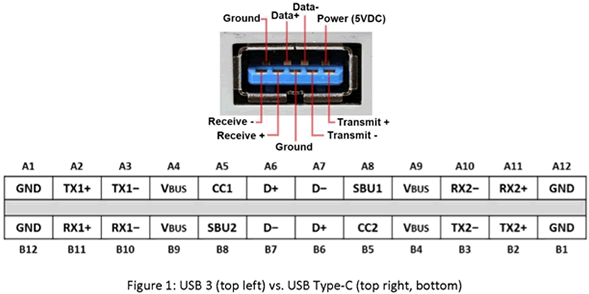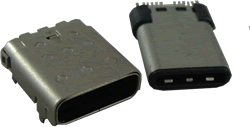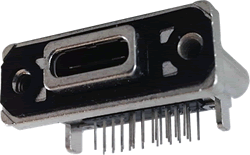USB’s evolution brings increased functionality & ruggedized design options
USB Type-C connectors bring bi-directional power and data transmission, simpler connectivity
Since its introduction in the 1990s, Universal Serial Bus (USB) has become a ubiquitous connector protocol, enabling standardized connections between computers and peripheral devices, such as keyboards, printers, and external disk drives. USB connections are now commonly used for smartphones, portable electronics, and wearable medical devices.
Initial development by the USB Implementers Forum (USB-IF) centered on simplifying connectivity for personal computers by consolidating functions of multiple custom interfaces with a single connector type and software configuration capable of providing low-speed data transfer and low power over a one-way cable. Subsequent demand for higher data transfer rates led to the current standard of USB 3.1 – dubbed SuperSpeed. Providing data transfer rates of 10 Gb/sec and power of 20V/5A, it became available in 2015. This significantly expanded performance and functionality of the USB interface.
While it was in process, developers were concurrently redesigning the connector to USB Type-C, which increased the contacts from 9 to 24. Additionally, this redesign of the USB features a double-sided connection capability to deliver full reversibility in the receptacle. It also supports bi-directional power and data transmission.

USB Type-C contact assignments
The combination of the USB Type-C connector with SuperSpeed USB 3.1 performance now provides consumer electronics design engineers with a truly universal interface protocol that uses a single cable and connector type. Combining power and data connections with a true two-way cable reduces the number of potential failure points, decreases maintenance costs, and simplifies installation of equipment. It also reduces cable clutter, which benefits users in all environments.
The increased number of contacts in the USB Type-C devices significantly expands the connector’s functionality, enabling simultaneous support of legacy protocols (USB 2.0) and USB 3.1 signal and power lines. With the significant increase in power, going up to 20V/5A, USB Type-C connectors let USB hosts to provide power to attached peripherals. It also supports devices with higher power demands, such as external monitors. Bi-directional power transfer transmits power back to the host USB port, which allows for a powered USB Type-C hub to replace external power supplies for tablets, phones, monitors, and other devices to further reduce cable clutter.
The addition of two high-speed signal pairs in the USB Type-C connector/cable means that alternate-mode communications can be established not only for USB 3.1 protocols, but also for multiple high-speed interfaces such as HDMI, DisplayPort, and other interfaces that would have previously required additional special ports and cables.
The USB Type-C redesign also presented a significant mechanical upgrade, with the larger size of the USB Type-C design providing more robust mechanical connections to the PC board. Different variations offer through-hole pins, as well as through-board attachment pins on the surface mount version that deliver increased mechanical strength compared to previous USB designs.

Standard design USB Type-C connectors
Standard USB Type-C connectors are typically constructed with copper alloy contacts featuring selective plating in the contact area and a stainless steel nickel-plated shell surrounded by a high temperature thermoplastic (UL94V-0) housing. The plugs are typically over-molded onto the cables. This configuration is suited for most consumer electronics equipment that is primarily designed for indoor or otherwise protected environments, including: smart phones and other mobile devices, portable computers, laptops and tablets, televisions, digital and DVD media players, set-top boxes, interior automotive infotainment and GPS systems, and telecommunication devices.
As design engineers expanded the application range for USB connectors, they required a connector design that provided all the benefits of the new USB Type-C connectors, but with enhanced environmental sealing and mechanical strength. The starting point for many ruggedized connector applications is the IEC-60529-IP67 specification, which ensures the connection is sealed against dust ingress and protected against high-pressure water jets, as well as immersion in water for limited periods of time.

Ruggedized design USB Type-C connectors
For certain consumer electronics applications where equipment is expected to operate reliably in extreme environments, a connector is required to exceed IP67 standards. This is achieved through upgraded materials used in construction (i.e., gold/nickel-plated contacts to resist corrosion), as well as design features, including through-hole mounting for a more mechanically robust PCB connection, a conductive silicon rubber gasket, and threaded panel connection points. These connectors also typically feature extended operating temperature ranges of -40°C to +105°C.
Applications for IP67+ connectors are typically in consumer electronics equipment that will be used in harsh environments or for specialized applications that require enhanced reliability and durable performance, including:
- Portable medical electronics for patient diagnostics and monitoring benefit from a single-cable connection with a rugged interface that transfers high bandwidth video and audio data while maintaining a constant power charge. Systems can be simple to use, while providing enhanced protection against cleaning sprays and bodily fluid contamination.
- High-resolution home surveillance cameras are transitioning to Ethernet-based that require USB Type-C’s increased bandwidth and a single-cable power and signal connection to simplify outdoor and remote installations.
- Fitness equipment, especially in commercial fitness centers, now require advanced interfaces to meet user expectations for high bandwidth infotainment and mobile device charging. Systems need a rugged connection that can withstand repeated mechanical stress and contamination such as sweat, cleaning solutions, and soda.
In summary, USB Type-C connectors offer a standard form factor that combines high-speed, high-bandwidth signal transmission capability with increased power handling. Components deliver a single-cable connection for a wide range of consumer electronics applications. Ruggedized IP67+ USB Type-C devices enable design engineers to gain the same advantages for systems that require operation in harsh environments or specialized applications.
Jen Lintner is Channel Marketing Manager at Amphenol Commercial Products

Recently posted:
[related_posts limit=”10″]





